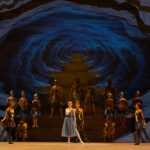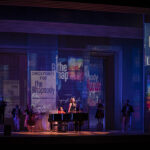With the news that Sweeney Todd: The Demon Barber of Fleet Street will return to the West Village in New York City this winter after an 11-year absence, it’s time to take a fresh look at Stephen Sondheim and Hugh Wheeler’s crowning masterpiece. Coincidentally, the timeless classic received two professional re-mountings in the summer of 2016 just a few hours from one another: one at the Shaw Festival in Niagara-on-the-Lake, Ontario, and the other at the Glimmerglass Festival, a summer opera company outside of Cooperstown, NY. The same story was interpreted in two different manners.
The story of a barber seeking revenge, a shop proprietor devising an easy route to wealth, and their scheme to kill gentlemen and bake them into pies has all the high drama and plot twists of grand opera. It also makes for an extraordinary theatrical experience.
“People come because this is a story about killing people and eating them, and they think that’s fun,” said Judith Bowden, set and costume designer for the Shaw Festival production. “We hope that the audience gets kind of disturbed, because then we’ve given them what they want.”

A “Visceral Environment” at Shaw
Bowden created the framework of a building tottering with wear, giving us glimpses of the lives within through its tattered walls and broken windows. Her inspiration, she said, came from the work of historian Peter Ackroyd and his books about the history of London.
“He talks about it as a breathing city, a beast, something that is alive,” she said. “London has been burned down, rebuilt, remodeled, and you can see the remnants as you walk down every street.” Bowden reflects this in her design by creating what she calls a “visceral environment”—one with its roots in the penny dreadfuls read by English people of the time.
“We’re very curious about places that look like something’s happened in them,” she said. When the chorus enters as the play begins, “They wake up the beast. They set the story in motion again.”

Within the patchwork walls, Shaw’s production positioned all of the tropes of this iconic play: the two-story building with its meat pie bakery below and tonsorial parlor above, the barber chair that shoves dead customers down a chute to the cellar, and the menacing red glow from the oven, where all manner of evil takes place.
“I’m sure everyone who does Sweeney plays with the use of red or orange light for the fire,” said Alan Brodie, lighting designer for the Shaw production. “Before Mrs. Lovett gets thrown in the oven, the beggar woman runs through the street. We let the oven light spill over and encompass the stage—the side walls go into amber, and then the amber and the cyc go into red.”
Brodie noted that Sweeney Todd is one of the most complex shows he’s ever done. “It’s so layered,” he said. “There’s almost always two overlapping narratives, and sometimes there are even three or four. You’re using different colors to tell that story, or different angles, to help the audience understand.” From the 350-light repertory plot (Sweeney ran in rep with Alice in Wonderland and A Woman of No Importance), Brodie used 160 units of the rep plot, including 16 Vari*Lite VL1000 AS, one Vari*Lite VL4000 Spot, nine ETC Source Fours with i-Cue mirrors, scrollers and DMX irises, and 22 Source Four LED Series 2 lights. To these he added 75 show-specific instruments.
The overall effect is a stylized yet traditional telling of the story, one that can measure up to every expectation of theatricality.
The Glimmerglass Reinterpretation
Audiences might expect that a production of Sweeney Todd by an opera company—one, in fact, that was attended by Sondheim himself a few hours before a scheduled appearance at the festival—would take the tale to an even higher level of visual drama.
Glimmerglass, however, went a different way.

The curtain opened on a reception room in an English village hall, with the cast in costumes that suggested the late 1950s. The bright white walls, wood-plank wainscoting and a long, bare wooden table served as the entire setting for the play, and the various villagers took on major and minor roles as the story unfolded, often settling back into the chorus as the action allowed.
“There’s a British photographer named Martin Parr, who is a cataloguer of banal British things,” said set designer Andrew Cavanaugh Holland. “Looking at his photos, you can see that every town in Britain has a village hall. Often you see the Union Jack flags that have been hanging there since the 1960s. The starkness and plainness all came out of that research.”
With this concept in place, the artistic staff decided to adhere strictly to the props and materials that might be available in a village hall. This made the construction of a second story, a body-dump chute and a massive oven essentially impossible, said Holland.

“It was a critique of capitalism, more of a Brechtian approach,” he explained. “It’s bookended by this super Brecht-style chorus. This kind of direct-address chorus— the kind that comes out and says, ‘Hey audience, listen up, we have a story to tell you’—can be in any time period to tell us the story. For us, especially after the film version, we wanted to approach it as freshly as we could, not like all of the things we’ve seen before.”
Instead of sliding bodies away out of sight, director Christopher Alden chose to have each murdered individual return silently to the ranks of the chorus. Meanwhile, a chorus member threw a bucket’s worth of blood—one for each slaying—onto the set’s white walls. The red ran down the walls and remained there, a gruesome reminder of Sweeney’s terror spree.
This looked like a nightmare scenario for the crew member who had to clean those walls after every performance, but the walls were built using Formica laminate. “We actually designed a trough into the wainscoting, and we put tampons in the trough to soak up the blood,” said Holland. “At the end of each performance, they just threw them away. It was still a bit of a nightmare for them, though.”

While many issues were solved to high dramatic effect, the oven turned out to be a stumper. The chorus wheeled an actual stove and oven—the kind you’d find in a 1950s kitchen—out onto the stage. In the climactic scene, Mrs. Lovett tucked herself neatly into the oven as if she were going for a car ride.
“We tried to downplay the bake house scene to make it more about Toby,” Holland said, referring to Mrs. Lovett’s assistant. “It may have been important in other productions, but in ours we weren’t really feeling it.”
Whether or not audiences picked up on the political statement is anyone’s guess, but the lack of visual effects at Glimmerglass certainly focused viewers’ attention on the astonishing voices of the opera cast. Opera does not use sound amplification, but the cast’s vocal range and power soared to the back of the house.
These two vastly different productions make us wonder what direction the new version at the Barrow Street Theatre in New York will take. The show that will open in February 2017 will place audience members at tables, where pie and mash will be served in an intimate 130-seat house. As for the content of the pie … we can assume it will not be the stuff butchered by Mr. Todd and served by Mrs. Lovett.


